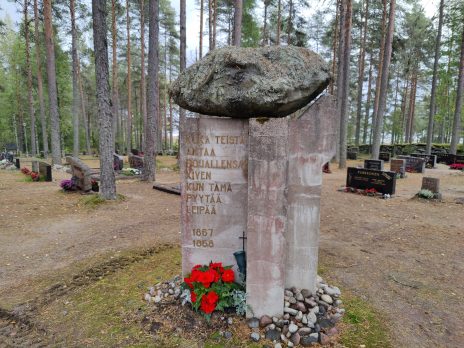History in Lestijärvi
Black and white photos of Lestijärvi

Years of famine 1867-1868
In the cemetery of Lestijärvi there is a remembrance monument for those who died in the years of famine in 1867-1868. The monument was designed by Sulo Kallionkoski. In the monument there reads a text: “Which of you gives your son a stone, when he is asking for bread”.
The misery of the years of famine:
The people were exhausted when living in the spring of 1867. They were talking about a spring that never came. The winter was snowy and according to Juho Niemi the road signs in the ice of lake Lestijärvi were still standing three days before midsummer. Again the frost took the crops in early September. In the spring of 1868 the situation was at its worst and the mortality rates at their highest. Of the 600 residents of Lestijärvi 65 died that year. The people were on the move and besides the hunger, they were spreading the typhoid fever. Some residents of Lestijärvi wondered off all the way to Vyborg (Viipuri) and died there due to the typhoid fever. Juho Niemi has told that three of these famine deaths were especially memorable. The guy of Leskelä died in an oven, Hirvisen Erkki died in front of the hay barn and “Lorikka-Aapa” died in the town of Syri. Lone pine tree bark was good news compared to hay and husks.
Church meeting transcript 11.11.1867
A church meeting transcript from 11.11.1867 describes the predicament well. The transcript reads the following desicion: “Since it seems impossible to live here from now on due to the only possible livelyhood being the production and sales of the forestry products, which will soon be no longer possible because the forests are nearly cut, the members of the church decided to humbly ask from the Lord Governor to inquire a living permit from the Russian Empire government. They ask if the before mentioned government would grant them a permit to live in the south part of Russia and that they would be given the privileges that were once given to immigrants who moved to Russia. If a preferable answer was given, the members of the church would pay off their depts to the grown with their personal belongings and move away during the next spring.” This decision was signed by the pastor Gustav Oskar Aspelin, who worked relentlessly to prevent the hunger.
Gustav Oskar Aspelin
As the chairman of the board for the Lestijärvi´s poors govenment Aspelin had to run the aid operations during the years of famine and made great favors to the people suffering from hunger. Due to his actions he received a nickname “Lestijärvi´s Josef” and the residents of Lestijärvi received multiple money and grain loans. The most remarkable aid during the worst years of famine was the decision to build a road from Halsua´s town of Kananen to Lestijärvi´s town of Kangasvieri. The payment for the workers was a fistful of grain.
Source: Pentti Laasanen

